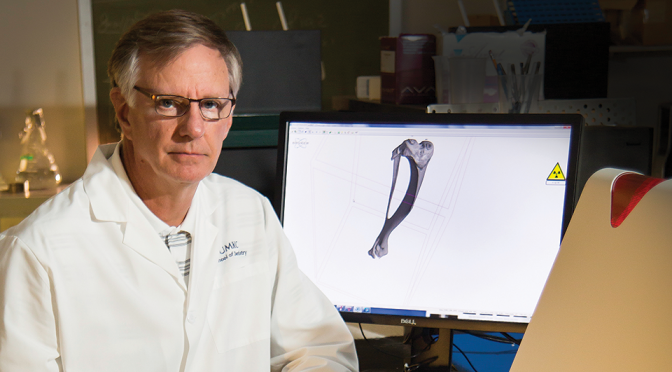With more than 25 years dedicated to the study of the molecular genetics of osteoporosis, the work of Mark Johnson, Ph.D., is the foundation for medications — both on the market and in clinical trials — developed to help patients suffering from bone loss.
As professor and chair of the department of Oral and Craniofacial Sciences and director of the UMKC Center of Excellence in the study of dental and musculoskeletal tissues, Johnson says he came to study osteoporosis through the back door.
“From a very young age I’ve always been interested in human diseases, especially inherited diseases,” he says.
His work with osteoporosis changes directions and grows as he continues to make discoveries related to the way the human skeleton creates and regulates bone mass. Nearly 40 million Americans are at risk for developing osteoporosis, a disease that generally occurs in older adults and is most commonly associated with menopause and estrogen loss. Johnson estimates that of those individuals who suffer from osteoporosis and experience an osteoporotic fracture, such as a hip fracture, nearly half die within a year of the injury.
Johnson’s research centers on discovering the keys to turning on bone mass production. Though there are drugs on the market to help with stimulating short-term bone replacement, Johnson hopes to discover the genetic basis for mass development in order to develop new long-term therapeutic strategies to turning on bone development.
Since older female adults experience a loss in estrogen and are the most common population to suffer from osteoporosis, Johnson and his team are researching how hormones affect osteocytes. Osteocytes control osteoblasts — which build bone — and osteoclasts — which remove bone. Their research also focuses on uncovering the role of estrogen and testosterone in regulating the LRP5 pathway, one of five pathways used by the human body to create all of its tissues and cells. Johnson’s research on the LRP5 pathway is supported by a significant grant award from the National Institutes of Health. This multi-year award, that is currently being considered for renewal, provides nearly $1.2 million per year.
Johnson hypothesizes that our muscles produce factors that condition the response of bone to mechanical load, and vice versa. Aging affects this crosstalk, leading to the decline of mass in these tissues in older individuals.
“There’s a remarkable biochemical coupling [between bone and muscle] that is really quite elegant and essential to the function of each tissue,” he says. “The old dogma was that bones provide an attachment site for muscle, which is necessary for locomotion. Muscles contract and apply load to bone, but it was very much a mechanical perspective. Now it looks like there is this molecular component to these two tissues that nobody suspected, and that’s really exciting.”
Johnson’s current work attempts to prove this correlation, though he is still waiting for results from his most recent study.
Further evidence for his hypothesis, and the potential reach of his work, lies in sarcopenia, something of a twin disease to osteoporosis. Sarcopenia, a muscle-wasting disease that causes loss of strength and function, is also associated with the aging process. When people with low bone density are examined, they often have muscle deficits. If Johnson’s hypothesis concerning the correlation of bone and muscle plays out, he says there are some exciting benefits to come.
According to Johnson, tens of millions of American are at risk for osteoporosis or sarcopenia each year. As the lifespan of humans extends and the population continues to grow older, Johnson says diseases like osteoporosis and sarcopenia will become an ever-increasing percentage of the U.S. and worldwide population.
“If we can identify the factors that play a role in the biochemical crosstalk between muscle and bone, and if it turns out that the expression of these factors is altered or diminished with aging, then one can envision a pharmaceutical approach in which replacement of one (or both) factors will restore the dynamic balance present at younger ages.”

